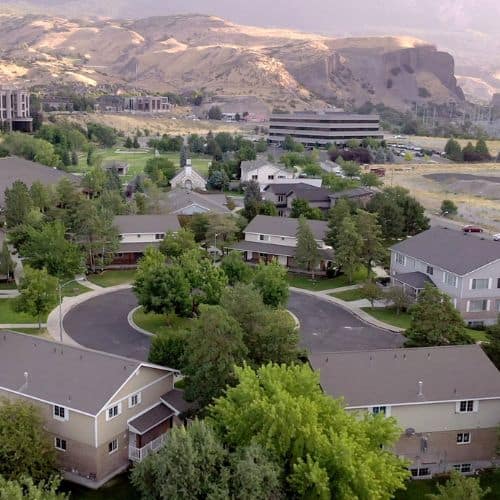
Anonymous’ Heritage School Testimony
1987-1989
I was sent to Heritage School directly from a psychiatric hospital when I had just turned 15. I am 49 now & still have nightmares. I know this is considered one of the “nicer” schools. I know it is very expensive. My memories are disjointed, but specific incidents are clear even all these years later. I have to present them as a numbered list because each one stands isolated in my memory, rather than part of a smooth narrative.
1. Solitary confinement & physical restraint were used for offenses ranging from running away, emotional outbursts, suicide attempts, or getting caught smoking. The “crisis” center was in the basement of one of the residential houses and consisted of tiny cells with a small window for staff to look in. There did not seem to be a limit on the time you could be kept there.
2. The staff psychiatrist, Dr Guernsey, routinely prescribed lithium and other powerful drugs to children who did not have relevant diagnoses. He tried to prescribe lithium to me — I have never been diagnosed as manic depressive. My psychiatrist from the hospital where I was previously a patient intervened when my parents asked for a second opinion, and I never had to take that drug. Some children suffered seizures due to improper or incorrectly dosed medications.
3. Homophobia was a consistent presence, albeit expressed carefully. If a romantic attachment formed between female students, the daily staff log would say things like “I can’t see anything positive coming of this friendship” no matter how supportive — or chaste! — the relationship was. The students were allowed to be as viciously homophobic as they wished. My counselor told me he did not approve of same sex relationships because he was Mormon, but claimed it would not affect his treatment of me. The transition home I was placed in held very homophobic views, and when they found out I was in a same sex relationship they locked me out of their house in Orem during a snowstorm. To avoid freezing to death, I broke the door out of the frame to get out of the cold. They sent me back to the school’s residence after that.
4. Denial of medical treatment, three examples: Heritage had an equestrian program, which featured heavily in their sales pitch. Not all of the horses were safe. I was experienced with horses but the equipment was in terrible shape, and a worn out leather rein snapped when I was riding a very young and untrained horse. I was thrown & landed on my back & head. For many days they kept me on a cot in the crisis center while I cried from the pain and begged to see a doctor. When they finally took me in, the x rays showed a spinous process fracture and there was also injury to the muscles of my lower back. Nothing much could be done because of the delay in treatment. I have lived with back pain ever since. When I was in my first transition home, I developed a massive infection after my wisdom teeth were extracted. The transition family would not take me to the doctor, as my jaw swelled & my fever increased. They finally relented & took me to the ER, where the doctor told me in private that I could have died had the infection gone untreated for much longer. He told the transition family that they needed to watch me day & night for the next few days. They returned me to my basement room and did not watch me, but fortunately the medication worked. There was a student who had an intellectual disability and was likely autistic as well (I do not know her diagnosis). When we were all doing laundry, we saw that she had a gynecological infection that had gone untreated for so long, it literally had eaten holes in her undergarments and had started to eat through her pants as well. Instead of helping her, staff just rolled their eyes while other girls bullied her. I remember her enduring the taunts with her eyes shut tight. I also remember being rooted to the spot, and not helping. These are the three instances that I personally know of regarding denial of medical care. There may have been others.
6. Bullying was ignored. These are some things I witnessed (not in order of importance or severity), in addition to the case mentioned above: Blatantly racist bullying was ignored. I’m not sure why it was ignored, but I can tell of two incidents that might shed some light. Around this time, I accompanied my transition home’s young children to LDS Sunday services, where the children were asked to give an example of how we could tell that a person was cursed by God. When a child put his hand up and said “dark skin?” the teacher clapped her hands and said “that’s right!”. The staff were entirely Mormon, and believe these teachings may have affected their attitudes toward students who were not white. On another occasion, our group’s therapist brought his own children to visit the residence, and they froze in shock when they saw an African American girl. She asked them “you never saw a black person before?” and they shook their heads, eyes wide as saucers. The therapist laughed. He was this girl’s therapist and was supposedly helping her through her issues. There was an ex-cop who ran the kidnapping program for the school (where children were grabbed from their homes without warning but with the consent of their parents), and also had some position of authority in the administration. I think his name was Dan, but I can’t be sure of it. One day, the girls from our unit were going on an excursion to a bowling alley. We were all loaded on a minibus, ready to go, when he walked up & ordered me off the bus. I stood there on the sidewalk and he ordered me to turn slowly in a circle while he looked me up and down. “You aren’t going.” he announced. I asked why, and he sneered and said “Because I don’t like you, that’s why.” I heard the female staff members quietly talking later about how that was unfair but that they couldn’t challenge him. They seemed very intimidated by him. There was a girl who was targeted for bullying as soon as she arrived. She was verbally and physically assaulted by the other girls in her room, and only defended by one or two girls in the whole unit. The staff ignored it, while most of the girls were amused (or secretly intimidated) bystanders. It got so bad that one day, as we were returning from dinner, she broke away from the group and made a run for the water tower on the school grounds. She climbed to the top, turned, and jumped. It was maybe 30 feet or higher, I’m not sure. In my memory she seemed to fall in slow motion. She landed on her feet, causing compound fractures of her legs. I wasn’t close enough to see, but I heard there were bones sticking right through her shoes. She wrote a letter to the unit from her hospital bed, saying that her intention wasn’t suicide. She said she just wanted to get up high, and then, while she had our attention, to tell us that she was a human being. She said she accidentally lost her balance when she got to the top and tried to turn on the ladder. She never returned to school and I never heard the staff talk about the incident again aside from one group meeting where they read the letter to us. The classrooms were mixed with students from the boys’ and girls’ school.. There was a male teacher who used to loudly, in front of the class, call out female students by name and order them to close their legs because “it smells like tuna in here,” to the great amusement of the male students. He seemed to be focused on bonding with the male students — I believe he was in charge of one of the residential units & not primarily a teacher of academics, though he did “teach” one of the classes.
7. Contact with family was an earned “privilege” and was monitored & censored, with phone calls terminated and letters unsent, if the student made claims that the staff did not like.
8. There was extreme and blatant favoritism shown to kids who became actively interested in converting to Mormonism
9. Many years later I asked for my medical records. The school did not want to hand them over. Eventually I forced the issue, and a stack of poorly xeroxed pages arrived with a rather tender cover letter, hoping to find me well and thriving, and reminding me that this was a difficult time in my life and that I might not be able to interpret the records. They suggested I employ a mental health professional to help me understand, but I had by then developed an allergy to mental health professionals. I believe some things were missing, or else never recorded. One thing in the pages struck me, though. I had been given a physical as part of my intake. The heritage staff who accompanied me later wrote that I “seemed to enjoy being nude in front of male medical personnel”. It makes me wonder what kind of mindset they had about the children in their care. I was 15, naked in front of adult strangers, and terrified. There were some kind people who worked at the school, particularly some of the young women who were there for the day to day.
In hindsight, over 30 years later, and a parent myself, I understand the fear that causes parents to seek this sort of treatment, and how easily that fear can be exploited. I also understand that some people seek employment in these therapeutic boarding schools because they want to work with children and help them with their problems. But other people seek employment in these facilities because they want access to children who lack credibility. These memories are true.
